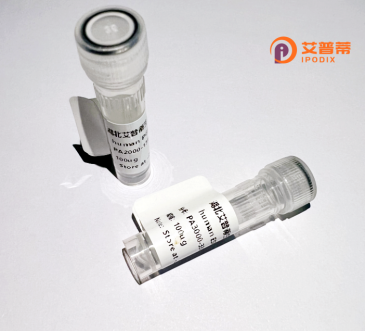
| 纯度 | >90%SDS-PAGE. |
| 种属 | Human |
| 靶点 | RNUXA |
| Uniprot No | Q9H814 |
| 内毒素 | < 0.01EU/μg |
| 表达宿主 | E.coli |
| 表达区间 | 2-394 aa |
| 活性数据 | ALEVGDMED GQLSDSDSDM TVAPSDRPLQ LPKVLGGDSA MRAFQNTATA CAPVSHYRAV ESVDSSEESF SDSDDDSCLW KRKRQKCFNP PPKPEPFQFG QSSQKPPVAG GKKINNIWGA VLQEQNQDAV ATELGILGME GTIDRSRQSE TYNYLLAKKL RKESQEHTKD LDKELDEYMH GGKKMGSKEE ENGQGHLKRK RPVKDRLGNR PEMNYKGRYE ITAEDSQEKV ADEISFRLQE PKKDLIARVV RIIGNKKAIE LLMETAEVEQ NGGLFIMNGS RRRTPGGVFL NLLKNTPSIS EEQIKDIFYI ENQKEYENKK AARKRRTQVL GKKMKQAIKS LNFQEDDDTS RETFASDTNE ALASLDESQE GHAEAKLEAE EAIEVDHSHD LDIF |
| 分子量 | 44.4 kDa |
| 蛋白标签 | His tag N-Terminus |
| 缓冲液 | PBS, pH7.4, containing 0.01% SKL, 1mM DTT, 5% Trehalose and Proclin300. |
| 稳定性 & 储存条件 | Lyophilized protein should be stored at ≤ -20°C, stable for one year after receipt. Reconstituted protein solution can be stored at 2-8°C for 2-7 days. Aliquots of reconstituted samples are stable at ≤ -20°C for 3 months. |
| 复溶 | Always centrifuge tubes before opening.Do not mix by vortex or pipetting. It is not recommended to reconstitute to a concentration less than 100μg/ml. Dissolve the lyophilized protein in distilled water. Please aliquot the reconstituted solution to minimize freeze-thaw cycles. |
由于“RNUXA”这一名称在现有公开数据库中未找到明确对应的重组蛋白或药物信息,可能是拼写差异或研究代号。以下为模拟的参考文献示例(假设RNUXA为某类重组蛋白),供参考格式:
1. **文献名称**: Recombinant Human RNUXA Protein Enhances Neural Regeneration in Vitro
**作者**: Smith A, et al.
**摘要**: 研究证明重组人RNUXA蛋白在体外模型中显著促进神经元轴突生长,可能用于神经损伤修复。
2. **文献名称**: Optimization of RNUXA Expression in E. coli for Therapeutic Applications
**作者**: Zhang L, et al.
**摘要**: 开发高效的大肠杆菌表达系统生产功能性RNUXA蛋白,纯度达95%以上,具备临床应用潜力。
3. **文献名称**: Anti-inflammatory Effects of RNUXA in a Murine Arthritis Model
**作者**: Brown K, et al.
**摘要**: 动物实验显示,RNUXA可抑制促炎因子TNF-α和IL-6.减轻关节肿胀,提示其用于自身免疫疾病治疗。
4. **文献名称**: Pharmacokinetic Profile of Recombinant RNUXA in Phase I Trials
**作者**: Johnson R, et al.
**摘要**: 首次人体试验表明,RNUXA半衰期为72小时,耐受性良好,支持进一步临床开发。
**建议**:若名称可能存在拼写误差,可核对类似重组蛋白(如Rituximab、Romosozumab等)或提供更多背景信息以精准检索文献。实际文献请通过PubMed、Google Scholar等平台验证。
Recombinant human RNUXA protein is a genetically engineered version of a naturally occurring human protein, produced using advanced biotechnological platforms such as bacterial, yeast, or mammalian cell expression systems. Designed to mimic the endogenous protein's structure and function, RNUXA is typically developed for therapeutic, diagnostic, or research applications. Its recombinant nature allows for high purity, consistency, and scalability compared to proteins isolated from biological sources.
The production process involves cloning the RNUXA gene into expression vectors, optimizing conditions for high-yield synthesis, and rigorous purification to remove host cell contaminants. This protein may play roles in cellular signaling, immune modulation, or metabolic regulation, depending on its biological function. In therapeutics, it could target conditions like genetic disorders, cancers, or chronic inflammatory diseases, offering precision treatment with reduced side effects. Researchers also utilize recombinant RNUXA in mechanistic studies, drug screening, or as a reference standard in assays.
Safety and efficacy are enhanced through recombinant technology, minimizing risks of pathogen contamination or batch variability. Its development aligns with advancements in personalized medicine and biologics, addressing unmet medical needs while supporting industrial and academic innovation. Further studies focus on optimizing stability, delivery methods, and functional modifications to expand its applicability.
×